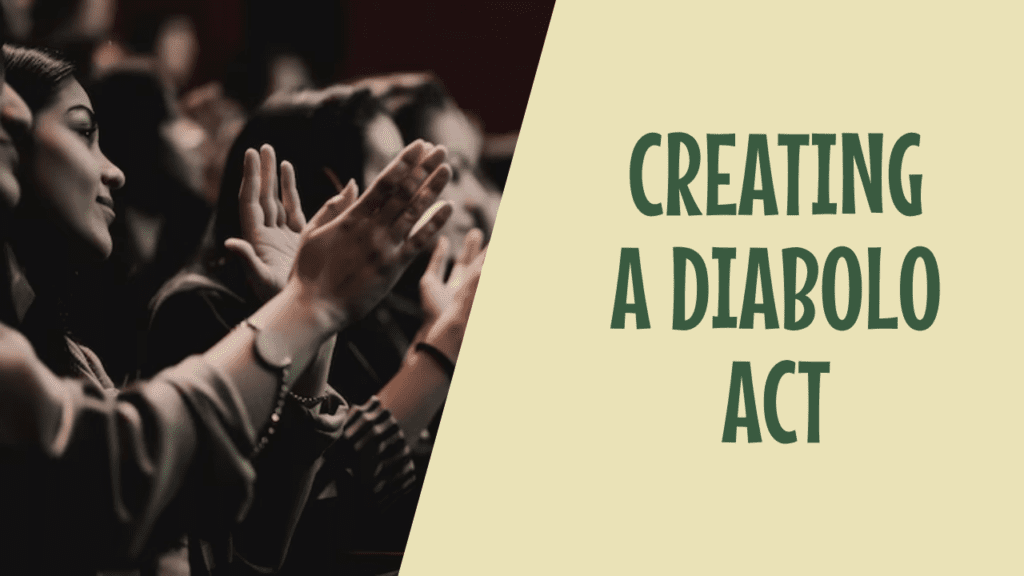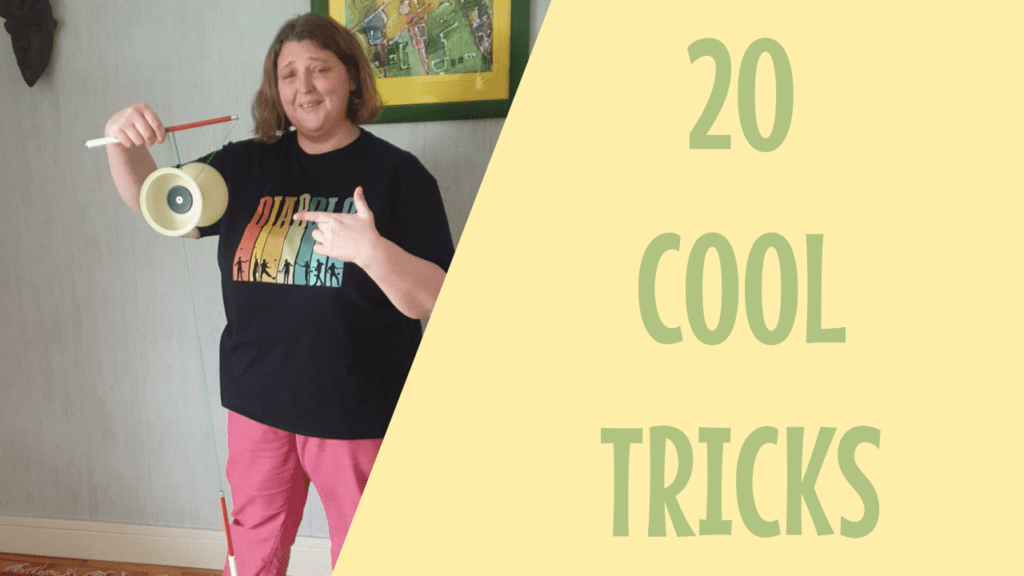Building a diabolo performance can be a daunting task. There are a lot of things to consider before you can even think about rehearsing.
The audience, tricks and music are the main points you need think about, but there’s a bit more to take into consideration.
1. The Audience
Knowing who you will perform for will help you build an act that is enjoyable for them.
There are two types of audience, the easy-ish one (non jugglers) and the one that knows better.
Depending on the type of audience, the things that make you look like a noob and the way to keep your audience engaged will differ wildly.
For the non juggler crowd, I always choose easy and very visual tricks as their tolerance for drops is low and they don’t know the difficulty of tricks. In my experience, you have one or two drops before the audience loses interest, so you need tricks that look good and that you have mastered. Make sure to include tricks like the elevator, a high toss, the infinite suicide or the whip catch.
For the music, I tend to choose something uplifting that will make the audience clap in rhythm. But if you have a good stage presence, you can choose any music that goes well with your character.
For jugglers, creativity and technique are more important than being solid. The tolerance for drops is higher especially if the tricks are new and impressive. Even non diabolo players will have a fairly good idea of the difficulty of tricks, so avoid easy ones if they are not new ideas. As for the music track, you can choose anything.
2. Your Character
Your performance doesn’t have to be a theater play, but having a bit of a story and/or character makes it more interesting. It will also help you engage with the audience and you can have interesting character moments if you drop.
Having an idea of what type of persona you want to have on stage will help you choose your music, your costume, how to handle drops… Do you want to be serious, goofy, shy or something else? Do you want to tell a story?
Your clothing matters! It should be comfortable and not hinder your juggling. For example avoid loose long-sleeved shirts as your sticks might get caught in the sleeves, buttons can catch the string… You also want the color of your costume to contrast with your props : so dark colors if your sticks and diabolos are white, yellow or any light color and light color clothes if your props are dark.
Make sure your costume makes sense with your character too.
Plan for drops!
When you drop during your routine or tangle the string, and you will, you need to know what to do. The audience will see it and if you’re just running after your diabolo or trying desperately to untie the string, you will feel crappy and the audience will feel sorry for you which is not what they came for.
Ask yourself “what would my character do in this situation ?” and plan ways of dealing with drops. When you drop or tangle the string, pause, look at the audience, acknowledge the drop (you can make a joke out of it or sell that the trick is hard, it doesn’t matter what you do, just stay in character) and continue your routine.
3. The Music
If you choose to have accompanying music to your performance (yes, no music is an option), the 2 criterias your music track(s) must absolutely meet are:
- something you can listen to on repeat without going crazy : to get your routine solid you will have to practice it a lot with your music, so choose wisely !
- the length you want : sometimes you will have to fit your routine in a certain amount of time and sometimes you’re free to choose. Find music that lasts the duration you want for your routine.
Choose a track with a tempo that matches yours, if you’re a fast juggler choose high tempo music and keep in mind your stage character and story.
To avoid any paperwork headaches, rights fees and legal issues, I always choose music with no copyrights. I like the selection you can find on this YouTube channel: https://www.youtube.com/channel/UCht8qITGkBvXKsR1Byln-wA
If you’d like more information about music in performance, check out this article.
4. The Choreagraphy
Here, I’m not talking about dancing, but about something much easier. Although if you can integrate dance moves, definitely do it! What you want to achieve is having your diabolo moves, your music and your character to look good together.
The tricks are only a small part of your act and synchronizing your moves with the music will come fairly quickly when you practice.
The things that really add depth to your performance is your character, the interactions with the audience and the way you move.
It can be as simple as doing a trick without looking at your diabolo and making eye contact with the audience instead, the way you walk around the stage, your facial expressions or the small movements you do while doing a trick. For example pushing my glasses up my nose when doing an infinite suicide is a small, easy movement that has a big effect.
5. The Tricks
As a rule of thumb, I start with an impressive trick or combination to get the audience’s attention, have fun in the middle (if you don’t enjoy the performance, no one else will) and finish with my most impressive trick to get the applause.
You can check the “How to build a routine” article for more help.
The acceleration in between combos is a natural pause for diabolo players, take advantage of it, make eye contact to tell the audience they have time to applaud.
When you’re on stage, your trick consistency goes way down, so expect to drop. I never had a flawless show, but to minimize the time I spend running after my diabolos, I only choose tricks that are at least 90% solid in practice, otherwise they don’t make the cut for the performance.
To create cool combos to include in your act, think about the string positions, tricks that give speed so you can do longer combos, easy impressive tricks (for the non jugglers), cool starts and stops.
6. Practicing And Refining
When you’re done with the first 5 steps, the grind begins! Now you can work on making your act solid.
Practice your routine with the music and the costume over and over again.
Film yourself, watch the practice session and take notes on when you drop, what looks good and what could be better.
Keep track of drops and ditch the combinations you struggle with. Replace them with an easier version or a totally different combo. Unless they are all jugglers, your audience will not know if a trick is difficult or not. As long as it looks good and you don’t drop too much, you will get the applause.
When rewatching your sessions, you will be able to spot where you can make adjustments, like if you’re standing in the same place for too long or if you’re focusing only on your tricks and forget the audience.
Then practice again with the changes and repeat this process of practicing and refining until you get your routine almost 100% of the time. On stage things tend to go worse than in practice, assume your worst practice session will be your average performance.
Examples Of Diabolo Acts
Spirit of the toy by Michael Menes :
When I was a non juggler, this is the diabolo act that started me on my diabolo journey !
I saw it and bought 2 diabolos the next day. Don’t underestimate simple and visual tricks for a non juggling audience !
Red dress by Lena Köhn :
This is another act aimed at a non juggling crowd, even though some of the tricks are definitely great for a diabolo playing audience.
Mocassins et brillantine by Eric Longequel :
I love this act ! Just watch and enjoy !
The remote by Chloé Fossard :
This is an example of a diabolo act for diabolo players : great technique and awesome creativity !
Building a diabolo act takes time and effort but is very rewarding. See you on stage !



